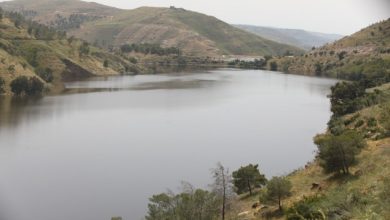ارشيف
NARC: Bonicam is one of the solutions to reduce the fodder bill

malfnews.net
Three-year research experiments in a number of stations of the National Agricultural Research Center (NARC) spread across Jordan concluded the importance of cultivating bonicam because of its role in reducing the fodder bill as green fodder of economic value due to its abundant production and high nutritional content of protein (18-22)% that varies according to the height of the plant, in addition to its ability to cope with different conditions, especially salinity, as it bears water salinity of 4,480 ppm and soil salinity up to 6000 ppm.
The Director General of NARC, Dr. Nizar Haddad, stated that NARC always seeks to develop scientific research to find non-traditional solutions to the challenges facing farmers, especially livestock breeders, such as high feed costs, which constitute a serious challenge for them, especially in the summer months that lack natural pastures, in addition to study the un-conventional water cultivation of bonicam and its role in saving water, increasing production in terms of quantity and quality, and its tolerance to several cases of salty soils and water.
Haddad added that the reduced numbers of livestock are because of high prices of fodder and its poor distribution throughout the year, especially green fodder.
Haddad encouraged farmers to plant bonicam, as it is a perennial crop and can be sustained for several years, and this will reflect positively on saving time and effort for farmers, not to forget the cost of labor and the irrigation network, and other agricultural operations.
Head of North Shouna Research Station for Un-conventional Waters, Eng. Yousef Al Omari, stated that bonicam is one of the value-added crops, that expand vertically to increase productivity per unit area, as it produces more than 10 seedlings throughout the year and is cut in the summer every (25-30) days. The productivity of one acre becomes 20 tons of green fodder, and it can be used directly, dried or converted into silage.
Al Omari indicated that bonicam is a strong plant that is resistant to diseases and insect pests, and that the areas with high temperatures (the Jordan Valley), are suitable habitats for the growth of bonicam, while cold areas are not recommended for its cultivation where the temperature drops below ten degrees, and that causes plant growth to be stunted.
On the bonicam nutritional value, the head of Ramtha Research Station for Un-conventional Water Department, Eng. Ahmed Abu Dalo, indicated that the percentage of protein varies according to the stages of plant growth. The protein content is estimated at (10-20)% when the plant is 1.5 meters high, it is palatable to the animal and easy to digest compared to plants of higher heights where it is more coarse and preferably used at this stage as silage.
On water needs of bonicam, Abu Dalo mentioned that the outputs of agricultural research under the conditions of the Jordanian environment indicate that bonicam needs adequate amounts of irrigation despite its tolerance to drought, and the amount of water is directly proportional to the increase in production, and that water needs of the plants range between (70-80)% of the readings of the evaporation basin in the summer months and according to the rise in temperatures. In general, water needs of bonicam are estimated at about 600 to 800 cubic meters per dunum annually, compared to the alfalfa crop, where the latter’s water needs are estimated at (1,550 – 1,800) cubic meters per dunum annually, and it varies according to the region, temperatures, soil quality and the amount of precipitation.
It was found through the study on the bonicam that the best production was when irrigated at a rate of 800 cubic meters per dunum annually.







